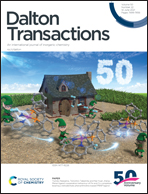A new bis-pyrazolylpyridine ruthenium(iii) complex as a potential anticancer drug: in vitro and in vivo activity in murine colon cancer†
Abstract
We synthesized and characterized the ruthenium(III) pincer-type complex [RuCl3(H2Lt-Bu] (H2Lt-Bu = 2,6-bis(5-tert-butyl-1H-pyrazol-3-yl)pyridine, 1) by elemental analysis, IR and UV-Vis spectroscopy, and the mass spectrometry (MS) method ESI Q-TOF. For comparison reasons, we also studied ruthenium(III) terpyridine complexes of the general formula [Ru(N-N-N)Cl3], where N-N-N = 4′-chloro-terpyridine (Cl-tpy; 2) or 4′-chlorophenyl-terpyridine (Cl-Ph-tpy; 3). A kinetic study of the substitution reactions of 1–3 with biomolecules showed that the rate constants depend on the properties of the spectator ligand and the nature of the entering nucleophile. The DNA/HSA binding study showed that in comparison to complex 1 (bis-pyrazolylpyridine), the other two (2 and 3) terpyridine complexes had a slightly better binding affinity to calf thymus DNA (CT DNA), while in the case of human serum albumin (HSA), complex 1 exhibited the strongest quenching ability. We demonstrated that 1 possesses significant in vitro cytotoxic activity against mouse colon carcinoma CT26 cells and in vivo antitumor activity in murine heterotopic colon carcinoma. Complex 1 induced G0/G1 cell cycle arrest and apoptotic death in CT26 cells. Additionally, 1 showed antiproliferative activity, as evaluated by the detection of the expression levels of the Ki67 protein. Furthermore, the in vivo results showed that 1 reduced primary tumour growth and the number and growth of lung and liver metastases, significantly prolonging the treated mice's survival rate. This study highlighted that 1 does not show hepato- and nephrotoxicity. Our data demonstrated the considerable antitumor activity of the ruthenium(III) pincer complex against CT26 tumour cells and implicated further investigations of its role as a potential chemotherapeutic agent for colon carcinoma.



 Please wait while we load your content...
Please wait while we load your content...